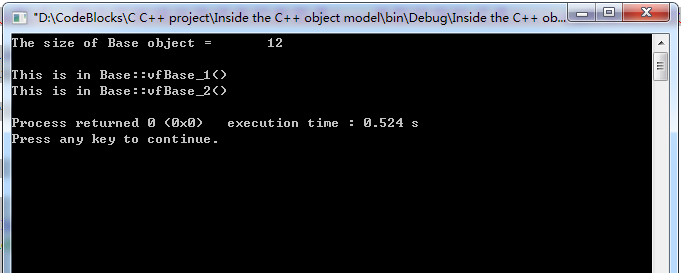对象内存布局 (1)
内容概要:
满足下面2个条件时,
1. 父类有虚函数,子类无虚函数(即无虚函数重写或无虚函数覆盖)
2. 非虚继承
类对象之内存布局
前述相关内容参考:
1. http://blog.csdn.net/pathuang68/archive/2009/04/20/4096088.aspx
2. http://blog.csdn.net/pathuang68/archive/2009/04/21/4096429.aspx
3. http://blog.csdn.net/pathuang68/archive/2009/04/21/4096521.aspx
Base类中有两个虚函数vfBase_1()、vfBase_2()和一个整形成员变量m_base, Derived类中有一个整形成员变量m_derived,二者的关系如下:

代码如下:
#include <iostream> using namespace std; class Base { public: int m_base; inline virtual void vfBase_1() { cout << "This is in Base::vfBase_1()" << endl; } inline virtual void vfBase_2() { cout << "This is in Base::vfBase_2()" << endl; } }; class Derived : public Base { public: int m_derived; }; typedef void (*VFun)(void); // 改为template形式,因为不能确定传进来的参数是Base类型的指针还是Derived类型的指针 template<typename T> VFun virtualFunctionPointer(T* b, int i) { return (VFun)(*((int*)(*(int*)b) + i)); } int main(void) { Derived d; cout << "The size of Base object = \t" << sizeof(Derived) << endl; cout << endl; int i = 0; while(virtualFunctionPointer(&d, i)) { VFun pVF = virtualFunctionPointer(&d, i++); pVF(); } return 0; }
运行结果:

Derived对象的memory layout图解如下:(这个图与深度探索C++对象模型中的不同,虚函数表中的第0项为type_info)
(注意:单重继承只有一个虚函数表)




